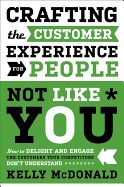Crafting the Customer Experience for People Not Like You
May 08, 2013
It’s easy to share something you love with someone else, particularly when you know that person likes the same things you do. It’s exciting to be the one to introduce them to something you know they’ll flip over. But what if you gushed enthusiastically about something to someone and their response was, “Why would anyone want that?
It's easy to share something you love with someone else, particularly when you know that person likes the same things you do. It's exciting to be the one to introduce them to something you know they'll flip over. But what if you gushed enthusiastically about something to someone and their response was, "Why would anyone want that?"
 Kelly McDonald's new book, Crafting the Customer Experience For People Not Like You: How to Delight and Engage the Customers Your Competitors Don't Understand looks at the above scenario from a customer service standpoint. To her, most customer service today is a "one size fits all" approach, satisfying some and turning away others. Those others are whom McDonald wants to help us serve better. Likely, they are not like us, with different ages, genders, ethnicities, and possibly even different moods than what we're in on a given day. Here is one example she cites:
Kelly McDonald's new book, Crafting the Customer Experience For People Not Like You: How to Delight and Engage the Customers Your Competitors Don't Understand looks at the above scenario from a customer service standpoint. To her, most customer service today is a "one size fits all" approach, satisfying some and turning away others. Those others are whom McDonald wants to help us serve better. Likely, they are not like us, with different ages, genders, ethnicities, and possibly even different moods than what we're in on a given day. Here is one example she cites:
 Kelly McDonald's new book, Crafting the Customer Experience For People Not Like You: How to Delight and Engage the Customers Your Competitors Don't Understand looks at the above scenario from a customer service standpoint. To her, most customer service today is a "one size fits all" approach, satisfying some and turning away others. Those others are whom McDonald wants to help us serve better. Likely, they are not like us, with different ages, genders, ethnicities, and possibly even different moods than what we're in on a given day. Here is one example she cites:
Kelly McDonald's new book, Crafting the Customer Experience For People Not Like You: How to Delight and Engage the Customers Your Competitors Don't Understand looks at the above scenario from a customer service standpoint. To her, most customer service today is a "one size fits all" approach, satisfying some and turning away others. Those others are whom McDonald wants to help us serve better. Likely, they are not like us, with different ages, genders, ethnicities, and possibly even different moods than what we're in on a given day. Here is one example she cites:
Someone who lives in a major metropolitan area is different from someone who lives in a small, rural community. Imagine the customer service implications of each scenario. The city dweller may appreciate speed and efficiency above all else. Super busy and rushed all the time, the city dweller has to spend valuable time fighting traffic just to get where he or she wants to go and has to fight crowds everywhere. If you were a merchant catering to this customer, perhaps the greatest customer service experience you could provide would be one that saves time and reduces hassles. But the rural customer may have none of those same issues. He or she may enjoy, above all else, the friendly, personal interaction received from someone considered to be a neighbor.In essence everyone is different, so why would we treat that complexity with an approach designed for only ourselves? Clearly, we shouldn't, and McDonald addresses this in terms of communication, technology, empathy, and more, each geared toward helping us understand how to make customers comfortable, interested, and willing to buy. The book is full of information that can help us understand people and their buying habits better, and it also keeps us focused on providing excellent service overall. Here are a sampling of McDonald's tips:
1. Make the right hires. Look for people who share your passion for great customer service and hire them. You can always teach them your business, but you can't teach someone how to empathize and put the customer first. 2. Train them on the importance of catering to diverse customer segments. Actively engage them in conversations and role-playing with different scenarios. 3. Be attuned to nuances. Mannerisms, expressions, and attitude can be clues to what customers really need from you, whether they voice it or not. 4. Be gracious. No matter what. Don't ever laugh at customers, embarrass them, or humiliate them. Be kind and solution-oriented, and you will win their loyalty.


